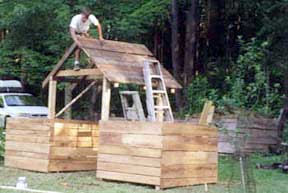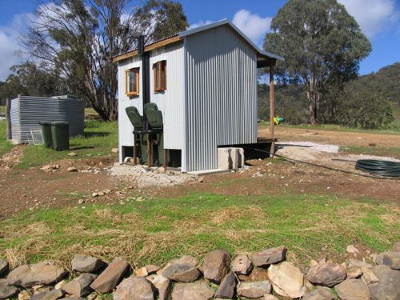
Building a better composting toilet
 This week, I've written about
cool
composting toilets
like the Clivus Multrum (easy to use but not as safe) and Joseph
Jenkins' thermophilic composting system (more time-consuming but
producing vegetable-garden-safe compost). Today, I'd like to
mention two systems that seem to combine the best of both worlds.
This week, I've written about
cool
composting toilets
like the Clivus Multrum (easy to use but not as safe) and Joseph
Jenkins' thermophilic composting system (more time-consuming but
producing vegetable-garden-safe compost). Today, I'd like to
mention two systems that seem to combine the best of both worlds.
The first system isn't
one I've actually seen online, but it seems to be an obvious upgrade to
Jenkins' Humanure Hacienda for those of us who don't mind cold
butts. Why not simply make a platform above each composting bin
and deposit your waste directly? Presumably, the slatted bin
sides and the addition of straw or hay and food scraps would still
prompt the pile to heat up, and there'd be no need to handle poop.
 A design that's already been
tried out is Milkwood's
rollie bin composting toilet. This Australian farm
brings in a lot of students and interns, so the proprietors didn't feel
comfortable handling strangers' waste. Instead, they built a
raised outhouse that dropped humanure into a rolling trashcan.
When the first can filled up, it could simply be rolled out of the way
to compost in the sun for a year while a new can took its place.
A design that's already been
tried out is Milkwood's
rollie bin composting toilet. This Australian farm
brings in a lot of students and interns, so the proprietors didn't feel
comfortable handling strangers' waste. Instead, they built a
raised outhouse that dropped humanure into a rolling trashcan.
When the first can filled up, it could simply be rolled out of the way
to compost in the sun for a year while a new can took its place.
What kind of interesting
composting toilet have you come up with? I'm very curious to hear
from anyone who's designed a thermophilic humanure composting system
that's not based on Jenkins' design.
| This post is part of our The Humanure Handbook lunchtime series.
Read all of the entries: |
Want more in-depth information? Browse through our books.
Or explore more posts by date or by subject.
About us: Anna Hess and Mark Hamilton spent over a decade living self-sufficiently in the mountains of Virginia before moving north to start over from scratch in the foothills of Ohio. They've experimented with permaculture, no-till gardening, trailersteading, home-based microbusinesses and much more, writing about their adventures in both blogs and books.
Want to be notified when new comments are posted on this page? Click on the RSS button after you add a comment to subscribe to the comment feed, or simply check the box beside "email replies to me" while writing your comment.

Using the bins is an interesting idea! Not only does it eliminate the need to run around with fresh crap, but these bins are watertight. So they won't leach fluids into the environment.
But there may be a couple of downsides.
Doc --- "Human manure is 90% E. coli." I find that very hard to believe. Where did you get that figure?
The trouble with just disposing of humanure by burying it, as we've found, is that if you don't go ahead and mix in the carbon materials, it ends up smelling and attracting flies. If you're going to use up all that carbon, it seems like you want to then put the product to use in the garden!
Estimates are that human feces is 66-85% by weight of water, 3-5% dietary fiber and 55% bacteria (which are also mostly water). See Latrine literature review.
But according to wikipedia, only 0,1% of our gut flora are E.coli or related. The aforementioned report states that only 7% of bacterial RNA collected from fecal samples belongs to earobic bacteria (which includes E.coli, Enterococci and Lactobacilli).
Anna, this reports also investigates pit latrines. I think it presents good evidence that they are not quite optimal. One might say an endorsement for thermophilic aerobic compostation from another angle.
Roland --- I knew I could count on you for some hard data! I see where Doc's numbers come from now --- it sounds like bacteria in general may be the majority of the dry weight of humanure.
By the way, I think I just won Mark over to the thermophilic humanure composting idea! I offered that he could put anything at all I'd been vetoing on the list in exchange. (Sounds a bit like the kind of deal you don't want to make in a fairy tale.... )
)
From what I've read so far, thermophilic composting is way better than a pit latrine. Both from an environmental and a health harzard standpoint.
As long as you add enough fluffy carbon-rich material to aerate the pile properly and cover it up against flies. Finding or making that material sounds like the biggest challenge.
Sorry for reopening this very old post, but it's such an interesting subject.
Any news?